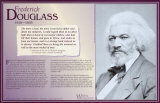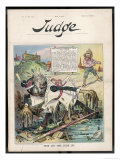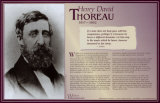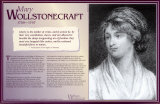|
|
|
|
|
Rachel Carson
b. 5-27-1907; Springdale, Pennsylvania
d. 4-14-1964
Poster Text: “The most alarming of all man's assaults upon the environment is the contamination of air, earth, rivers, and sea with dangerous and even lethal materials.” Rachel Carson
When Rachel Carson's book Silent Spring appeared in 1962, it sent a shock through America. In this book, one of the most important works ever written about ecology, Carson warned that humans were misusing chemical pesticides. She gave examples from around the United States and argued that unless things changed we might face a future without the songs of birds, or the sounds of any animals at all. This shocking book prompted Congress and President Kennedy to pass laws to prevent this “silent spring.”
When Silent Spring was published, Rachel Carson was already one of America's most respected science writiers. She graduated from the Pennsylvania College for Women in 1929 and received her master's degree in zoology from Johns Hopkins University. She worked for the federal government as a writer, editor, and aquatic biologist for 15 years before resigning in 1952 to write full-time.
Carson wrote many popular books and articles about the wonders of nature. Her book The Sea Around Us and its follow-up, The Edge of the Sea, taught people about the delicate balance between ocean and shore life. But it was with Silent Spring that she made her biggest impact. It has been called the basis for the modern environmental movement. After its publication, Carson continued to write, and she testified before Congress about the dangers of pesticides. She died in 1964 of breast cancer and heart disease. Her final book, The Sense of Wonder, was published the following year.
• more Rachel Carson posters
|
|
|
|
Frederick Douglass
b. 2-14-c.1818; Maryland
d. 2-20-1895
Poster Text: “The more I read, the more I was lead to abhor and detest my enslavers. I could regard them in no other light than a band of successful robbers, who had left their homes, and gone to Africa, and stolen us from our homes, and in a strange land reduced us to slavery. I loathed them as being the meanest as well as the most wicked of men.”- Narrative of the Life of Frederick Douglass
Frederick Augustus Washington Bailey was born into slavery in rural Maryland – he never knew exactly when he was born. As a child, he wore nothing but a shirt, ate little but mush, and lived in fear of the brutal beatings that were common on the plantation. When he was 7 or 8 years old, he was sent to Baltimore to serve as a houseboy for the Auld family. Mrs. Sophia Auld taught “Freddy” the alphabet and some simple words before her husband ordered her to stop. But Freddy did not stop, and he learned how to read by tricking some white servants into helping him. By the time he was went back to work in the fields, he had made up his mind to be free. He held on to this feeling through several years of horrible treatment as a field slave. He finally escaped in 1838 and made his way north to New Bedford, Massachusetts, where he took the name “Frederick Douglass.”
An anti-slavery group invited Douglass to talk to them. He soon became known as a powerful speaker and a leader of the abolitionist movement. His autobiography, Narrative of the Life of Frederick Douglass, An American Slave, Written by Himself, was published in 1845. The book was very popular because Douglass wrote about the evils of slavery in his own truthful words.
After Narrative of the Life of Frederick Douglass was published, Douglass was the best-known and most respected African American leader in the nation. He founded a magazine, published two more works of autobiography, and helped recruit African American troops during the Civil War. After the Civil War, Douglass served as Minister to Haiti and as the Marshal for the District of Columbia. He died in 1895.
• more Frederick Douglass posters
• Black History posters
|
|
|
|
Anne Frank
b. 6-12-1929; Frankfurt am Main, Germany
d. Feb/March, 1945; Bergen-Belsen Camp
Poster Text: “How wonderful it is that nobody need wait a single momnet before starting to improve the world.”
The Diary of a Young Girl
Perhaps no book sums up the tragedy and bravery of humanity better than Diary of a Young Girl, by Anne Frank. It was published in 1947, two years after its author died at the age of 15 in the Bergen-Belsen concentration camp in Germany. In her diary, Anne wrote to an imaginary friend named Kitty and described her life as she, her family, and others hid from the Nazis in the attic in Amsterdam, Holland, during World War II.
Anneliese Marie Frank was born in Frankfurt, Germany in 1929. Her family moved to Holland a few years later to escape growing prejudice and violence against Jews, but life grew much more difficult when the nazix invaded Holland in 1940. When Anne's older sister, Margot, received a notice to report to a Nazi “labor” camp on July 5, 1942, and a policeman came to the door that very day, the Franks knew that they had to go into hiding. The next day, they began their life in a secret two-room annex above Anne's father's law office.
The Franks and four other Jews lived in the annex for more than two years. They had to remain almost completely silent and motionless during the day to avoid detection while people worked in the office below – they could only move around at night and on the weekends. Several employees of the law firm helped them, bringing them food, drink, and news of the outside world.
Anne had received her diary as a present for her 13th birthday in June 1942 and it was here that she recorded her thoughts, her fears, her dreams, and her impressions of the world. Anne's sadness and fear come through loud and clear, but so do her wit and courage in the face of such horrible conditions.
In August 1944, someone betrayed the eight Jews hiding in the house to the Nazis, and they were arrested. They were sent to various prison and death camps. Anne and Margot died of typhus just months before the war ended; Anne's father, Otto, was the only one of the eight to survive. Miep Gies, a secretary who had helped the Franks hide, discovered Anne's diary and kept it. Otto Frank published portions of his daughter's diary two years later. Since then, The Diary of a Young Girl has been translated into most of the languages in the world. Anne Frank's honest, intelligent voice puts a human face on the almost unthinkable tragedies suffered at the hands of the Nazis. Her book has taught people everwhere about the dangers and horrors of war and prejudice.
• more Anne Frank posters
• more Women Writers posters
|
|
|
|
José Marti -
b. 1-28-1853; Havana, Cuba
d. 5-19-1895
There is a monument in Revolution Square in Havana, Cuba, dedicated to a poet named José Julian Martí y Pérez. Although he isn't well known outside of Cuba, José Martí is one of that country's greatest heroes. He sought to change his country's history with his words and actions, and he ended up paying the ultimate price for freedom.
José Martí was born in Havana in 1853. Cuba was a Spanish colony, and the young Martí believed his land should be independent. He published a newspaper devoted to Cuban freedom when he ws only 16. His revolutionary views got him in trouble with the authorities. He was sentenced to six years of hard labor, but he was released after seven months and exiled to Spain. There he earned two college degrees and published articles and books about Cuban independence.
Martí then taught in Mexico and Guatemala, served as a diplomat in various South American countries and lived for fourteen years in the U.S., where he was a journalist and commentator. He also wrote two books of poetry Ismaelillo (1882) and Versos Sencillos (1891). (The words to the famous Cuban song “Guantanamara” are based on one of his poems.) But he ached to return to Cuba and work for its freedom.
In 1892, while he was still living in the U.S., Martí founded the Cuban Revolutionary Party and spent the next three years trying to raise an army to fight the Spanish. He finally succeeded, and they landed in Cuba in 1895. He was filled in the battle of Dos Rios on May 19 of that year, but his example and his writings inspired a struggle that continued until Cuba won its independence, seven years and a day after he lost his life. - text from Writers Who Changed the World poster series, n/a
Jose Marti quotes ~
• “Anything that divides men from each other, that separates them, singles them out, or hems them in, is a sin against humanity.” My Race
• more Latino Writers
• Selected Writings
|
|
|
|
Upton Sinclair
b. 9-20-1878; Baltimore, Maryland
d. 11-25-1968
Poster Text: “He was working n the steaming pit of hell; day after day, week after week – until now, there was not an organ of his body that did its work without pain, until the sound of ocean breakers echoed in his head day and night, and the buildings swayed and danced before him as he went down the street.” The Jungle
Upton Sinclair wrote more than ninety books, but his most famous is The Jungle. This novel, which exposed the unsanitary conditions of the meatpacking industry in Chicago and the terrible way its workers were treated, caused a national sensation.
When President Theodore Roosevelt read the book, he ordered an investigation that lead to the Pure Food and Drugs Act and the Meat Inspection Act. The Jungle helped make all Americans safer – and it helped make Upton Sinclair famous around the world before he turned 30.
Sinclair was born in Baltimore, Maryland, and grew up in New York City. His father was an alcoholic and his parents were poor, but he spent much of his time with his rich grandparents. He started writing stories for magazines when he was 15, and two years later he was supporting his entire family with the money he made writing. Sinclair's first novel, Springtime and Harvest, was published in 1901. But his life changed forever five years later when The Jungle was published. The novel painted a very realistic picture.
Sinclair actually worked in a meat packing plant so that he could write about the conditions there. With this book, he became one of the best known “muckrakers” – a group of writers who uncovered corruption and dangerous business practices.
Although his next few novels did not sell many copies, Sinclair also became famous for his political career. He was a socialist who believed that businesses and rich people should have to share their money with the poor. This idea gained a lot of ground during the Great Depression, and Sinclair ran for governor of California twice as a Democrat. Although he lost both times, he received almost 900,000 votes in the 1934 election.
Sinclair continued to work as a novelist and journalist for many years. He won the 1943 Pulitzer Prize for fiction for Dragon's Teeth, a novel about the rise of Nazism in Germany. In 1953, he moved to Buckeye, Arizona, where he lived until his death in 1968.
• Labor Posters
|
|
|
|
Harriet Beecher Stowe
b. 6-14-1811; Litchfield, CT
d. 7-1-1896
Poster Text: “I beseech you, pity those mothers that are constantly made childless by the American slave-trade! And say, mothers of America, is this a thing to be defended, sympatized with, passed over in silence?”
Legend has it that when Abraham Lincoln met Harriet Beecher Stowe in 1862 he said to her, “So you're the little lady who wrote the book that started this great war.” While Uncle Tom's Cabin didn't exactly start the Civil War, its strong anti-slavery message made abolitionists out of many Americans.
Harriet Beecher was born in Litchfield, Connecticut. Her father, the Reverend Lyman Beecher, was well-known preacher who spoke against slavery. When she was 21 Harriet moved with her family to Cincinnati, Ohio, where she met and married a professor named Calvin Stowe, who encouraged her to pursue her dream of becoming a writer. Her first book of stories, The Mayflower, was published in 1834. She eventually published more than thirty books. Stowe's biggest success, entitled Uncle Tom's Cabin: Or, Life Among the Lowly, was published in 1852. The main characters in this novel are two slaves: Eliza, who escapes via the Underground Railroad to Canada, and Uncle Tom, who is patient and loyal, but ends up dying to protect two runaway slaves from an evil overseer. “Tomism” immediately swept the nation – the novel was the biggest success in publishing history up to that point, selling more than 500,000 copies in five years.
Uncle Tom's Cabin was important because it brought the horrors of slavery home for many people around the world who had no direct experience with it. Harriet Beecher Stowe challenged Northerners to think of slavery as an American problem, rather than just a Southern problem. She will always be remembered for this book, which remains one of the most important American novels ever written.
• Harriet Beecher Stowe posters
|
|
|
|
Henry David Thoreau
b. 7-12-1817; Concord, MA
d. 5-6-1862, Concord, MA
“If a man does not keep pace with his companions, perhaps it is because he hears a different drummer. Let him step to the music which he hears, however measured or far away.”
Walden
Walden Pond, located about an hour from Boston, Massachusetts, is the most famous pond in the world. It was immortalized by Henry David Thoreau in his classic book Walden. In this work, Thoreau writes about the two years he lived by himself in the woods aournd Walden. He celebrates the beauty of nature, encouraging people to live more simply and to take care of the natural world – in his “Civil Disobedience” inspired Mahatma Gandhi and the Rev. Martin Luther King, Jr., in their campaigns to stop injustice.
Thoreau grew up in Massachusetts and attended Harvard College, where he studied literature and history. But he wanted a deeper connection to what he had learned – he once remarked that Harvard taught him all of the brances of knowledge, “but none of the roots.” To find those roots, Thoreau worked many differnt jobs, including surveying, teaching, farming, and house painting. He wrote poetry, essays, and journals, and traded letters with some of the most famous thinkers and writers of the time. He also spoke out strongly against slavery and greed.
But Thoreau's greatest experiment began on July 4, 1845, when he moved into a small house he had built near Walden Pond. He lived there, alone, for the next two years. Thoreau was trying, as he says in Walden, to “make my life of equal simplicity, and I may say innocence, with Nature herself.” Walden is a book that has halped many people see that life does not have to be complicated to be wonderful.
Thoreau wrote “Civil Disobedience” in 1846, after he was arrested for not paying his poll tax. He was protesting because this tax was used to support the Mexican-American War, which he opposed. He spent a night in jail and came out stronger than ever in his belief that every human being must stand up for what he or she thinks is right, even if it means politely breaking the law. Thoreau died in 1862.
• more Henry David Thoreau posters
• ecology posters
|
|
|
|
Mary Wollstonecraft
b. 4-27-1759; London, England
d. 9-10-1797
Poster Text: “Liberty is the mother of virtue, and if women be, by their very constitution slaves, and not allowed to breathe the sharp invigorating air of freedom, they must ever languish like exotics, and be reckoned beautiful flaws in nature.”
The book Vindication of the Rights of Woman was published in England in 1792. The author, Mary Wollstonecraft, wrote that men were given more respect and power in society than women were, and that women were taught only to be concerned with their looks and with getting married. Wollstonecraft believed mothing would change until men and women received the same education. Vindication of the Rights of Woman caused a huge controversy in England – but this was nothing new for Mary Wollstonecraft.
Wollstonecraft was born in London, and her family moved all over England and Wales because of her father's financial troubles. She left home at 19 and became a governess, watching over and teaching young children. She also helped her sister found a school. Eventually, she met Richard Price, a radical preacher who helped her form her thoughts about how unfairly women were treated in English society. With his encouragement, she began to write pamplets and books.
Wollstonecraft became famous (and infamous) when Vindication of the Rights of Woman came out. The book was very important in England and around the world. Her ideas, including the view that women should be seen as equal to men, were revolutionary at he time. Because of Vindication, Wollstonecraft has been called the mother of the feminist movement. Not everyone was happy about her work, however; the writer Horace Walpole called her “a hyena in petticoats.” Mary Wollstonecraft wrote many other works, including two novels. She died after giving birth to her second daughter, Mary Wollstonecraft (Godwin) Shelley, who grew up to write Frankenstein.
• more Mary Wollstonecraft posters
|
|
|
|
Emile Zola
b. 4-2-1840; Paris, France
d. 9-29-1902; Paris
I have but one passion, the search for light, in the name of humanity which has suffered so much and is entitled to happiness. My fiery protest is simply the cry of my very soul. – J'Accuse
French journalist and author Emile Zola's novels had already made him controversial by 1898. His works told about the uglier side of life, and titles like L'Asspoimmoir (The Drunkard) and Les Bete Humaine (The Human Beast). In Germinal, Zola explored how badly French coal miners were treated and hinted they should strike for better conditions. He has been called the greatest journalist of the 19th century.
But Zola's most famous literary work was neither a novel nor an article; it was a letter published in a newspaper. He wrote this letter in 1898 to protest the treatment of Alfred Dreyfus, a French soldier who was in prison for life at Devil's Island. Dreyfus, who was Jewish, had been convicted of spying for Germany, but French courts – and the French government – ignored later evidence that proved Dreyfus was innocent. Zola was horrified at this, and wrote a letter to French president Felix Faure that came to be called “J'accuse ...!” which means “I accuse”. This letter, published in the newspaper L'Aurore, claimed that the governemnt, the military, and the judicial system had teamed up against Dreyfus because he was Jewish.
“J'accuse” made Zola a hearo around the world for his courage in taking on his own nations' government. In France, however, he was convicted of libel – writng something that is not true – and sentenced to prison. He fled to England, and his wife sold nearly all of his estate to pay his legal bills. Zola and Dreyfus were both pardoned when the truth came out that Dreyfus was innocent. Sadly, Zola died of asphyxiation soon after he return to France – some have speculated that he was murdered by his enemies. But his famous letter, which shone like a light on anti-Semittism (sic) in 19th century France, will live on forever.
• more Emile Zola
|
|
|
previous page | top
|
|
I have searched the web for visual, text, and manipulative curriculum support materials - teaching posters, art prints, maps, charts, calendars, books and educational toys featuring famous people, places and events - to help teachers optimize their valuable time and budget.
Browsing the subject areas at NetPosterWorks.com is a learning experience where educators can plan context rich environments while comparing prices, special discounts, framing options and shipping from educational resources.
Thank you for starting your search for inspirational, motivational, and educational posters and learning materials at NetPosterWorks.com. If you need help please contact us.
|
|
|
















